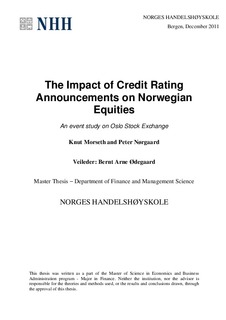| dc.description.abstract | This paper studies the effect of credit rating announcements on daily stock returns for Norwegian equities listed on Oslo Stock Exchange. The empirical study is conducted using an event study, defining an event as a rating action from one of the credit rating agencies (CRA’s) Standard & Poor (S&P) and Moody’s. Besides core rating changes the paper also investigates several categories of other rating actions and subsamples of rating actions with certain features.
Rating news reflects the CRA’s review of the company and its ability to service its debt. It is a signal to the market about the expected future performance of the company. However as a credit rating in focusing on the liability side, a credit rating can also signal the CRA’s opinion about how management is prioritising a company’s claimants.
If the market is concerned about the CRA’s assessment and views it as an analysis of performance, we expect to find negative (positive) abnormal stock returns around negative (positive) rating announcements. If the CRA’s actions are viewed as signals about altered prioritising of claimants, the opposite logic could to some degree apply. We initially assume that negative (positive) credit actions are interpreted as negative (positive) for both equity and debt holders by the market. We therefore anticipate negative abnormal equity returns for negative news and vice versa for positive news. Significant negative abnormal stock returns for negative rating actions, especially downgrades, are in line with most previous studies on the subject. On the different positive rating news, prior research is less conclusive.
The analysis does not show any significant abnormal return in the case of downgrades. However, our results display a significant negative abnormal return when aggregating all negative rating announcements, i.e. including outlook and watchlist placements. Investigating this further we find that the most severe rating action is a negative watchlist placement which shows large and significant negative abnormal returns. In addition, the negative effect is larger for small firms, unexpected rating news is more severe and a rating change between investment and speculative grade is more dramatic for the issuer’s stock price. Our analysis also shows that the significance of negative rating announcements in the Norwegian market seems to have increased after the credit crisis in 2008. | no_NO |
